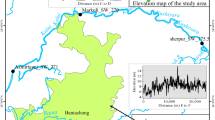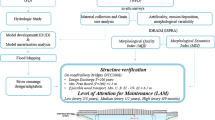Abstract
During the last decades, river floods accounted for enormous damages especially in highly developed and/or densely populated regions worldwide. Moreover, due to anthropogenic alterations of hydrology and river morphology (climate change, land use changes in the catchment, channelling and constricting rivers) and due to the ongoing accumulation of values (such as settlements, infrastructure facilities, etc.) in flood prone areas, this amount of damages is likely to rise in future. Integrated flood risk management is legally in force and aims at reducing the negative effects of floods by combining structural and non-structural flood protection measures. Non-structural measures such as the preservation or restoration of floodplains are considered by the EU Floods Directive as an effective tool for reducing flood risks. For most of the rivers, however, very little is known about the effectiveness of floodplains in regard to hydrological and hydraulical flood hazard reduction. This lack in knowledge often obstructs the integration of these natural flood retention processes into the concepts of integrated flood risk management. In the present study, the Austrian Danube was investigated along its entire 350 km length, determining reaches and floodplains with high relevance for flood water retention and thus for reducing flood hazards downstream. A novel analysis based on one-dimensional and two-dimensional hydrodynamic-numerical modelling, using hydrological and hydraulic parameters defined under the so-called floodplain evaluation matrix method (FEM; Habersack et al. in Nat Hazards, in print, 2013), was carried out to evaluate retention effectiveness on various spatial scales. The results illustrate the magnitude and the variability of flood retention and hydraulic parameters with respect to different hydrological settings (flood wave shape, recurrence probability).







Similar content being viewed by others
References
Barredo JI (2007) Major flood disasters in Europe: 1950–2005. J Nat Hazards 42:125–148
Bauer C (2004) Bestimmung der retentionspotenziale naturnaher Maßnahmen in Gewässer und Aue mit hydraulischen Methoden, Heft 16/2004. Kasseler Wasserbau-Mitteilungen. Fachgebiet Wasserbau und Wasserwirtschaft, Universität Kassel, Kassel
Blackwell MSA, Maltby E (2006) Ecoflood guidelines—how to use floodplains for flood risk reduction. European Commission, Office for Official Publications of the European Communities. Luxembourg. ISBN 92-79-00962-1
Bui MD, Bernhart HH, Kleemeier H (2005) Morphological numerical simulation of flood situations in the Danube River. Int J River Basin Manage 3(4):283–293
Chovanec A, Waringer J, Straif M, Graf W, Reckendorfer W, Waringer-Löschenkohl A, Waidbacher H, Schultz H (2005) The Floodplain Index—a new approach for assessing the ecological status of river/floodplain-systems according to the EU water framework directive. Large Rivers 15(1–4):169–185
Danube FloodRisk (2012) Danube atlas—hazard and risk maps. SEE-Programme of the European Union, Bucharest
De Kok J-L, Grossmann M (2010) Large-scale assessment of flood risk and the effects of mitigation measures along the Elbe River. Nat Hazards 52(1):143–166
De Loe R, Wojtanowski D (2001) Associated benefits and costs of the Canadian Flood Damage Reduction Program. Appl Geogr 21:1–21
Dworak T, Görlach B (2005) Flood risk management in Europe—the development of a common EU policy. Int J River Basin Manage 3(2):97–103
Ebert S, Hulea O, Strobel D (2009) Floodplain restoration along the lower Danube: a climate change adaptation case study. Clim Dev 1(3):212–219
EU Directive (2007/60/EC) Directive on the assessment and management of flood risks. European Parliament and Council, Official Journal of the European Union, L 288/27-34, 6 Nov 2007
Evans NR, Gregory WD, Thom RM, Borde AB (2005) Prioritizing restoration sites in the Columbia river estuary. In: Proceedings of the 25th annual ESRI international user conference. San Diego, CA, USA, 25–29 July 2005
Fischer M (2008) Ungesteuerte und gesteuerte Retention entlang von Fließgewässern—Beurteilung der Wirksamkeit möglicher Maßnahmen unter Verwendung hydrodynamisch-numerischer Modellierung (Controlled and un-controlled retention at rivers—assessment of effectiveness of potential measures by using hydrodynamic-numerical modelling). Doctoral Thesis, Technische Universität München, ISBN 978-3-940476-11-1
Freeman RE, Ray RO (2001) Landscape ecology practice by small scale river conservation groups. Landsc Urban Plan 56:171–184
Freshwater D, Arthur LM (1985) Towards an assessment of the economic impacts of the Canada-Manitoba and Canada-Saskatchewan Flood Damage Reduction Programs. Faculty of Agriculture, University of Manitoba, Occasional Series 15
Habersack H, Moser A (2003) Plattform Hochwasser—Ereignisdokumentation Hochwasser August 2002 (Platform floods—documentation of the flood in August 2002). Lebensministerium, Vienna
Habersack H, Fuchs H, Sattler S, Wind H (2003) Hochwasser 2002—Datenbasis der Schadensbilanz 2002 (Flood 2002—data basis of damage records 2002). StartClim.9. ZENAR—Zentrum für Naturgefahren und Risikomanagement, Vienna
Habersack H, Rudolf-Miklau F, Godina R, Krapesch G (2006) Hochwasser 2005—Ereignisdokumentation (Flood 2005—documentation of the flood event). Lebensministerium, Vienna
Habersack H, Bürgel J, Kanonier A (2009a) FloodRisk II—Vertiefung und Vernetzung zukunftsweisender Umsetzungsstrategien zum integrierten Hochwassermanagement (Consolidation and cross-linking of future-oriented implementation strategies for an integrated flood risk management). Bundesministerium für Land- und Forstwirtschaft, Umwelt und Wasserwirtschaft. Vienna. ISBN 978-3-85174-071-4
Habersack H, Schober B, Wagner B, Reichel G, Verdino R (2009b) Retentionsraumanalysen an der österreichischen Donau im Zusammenhang mit der EU-Hochwasserrichtlinie—Endbericht (Analysis of retention effectiveness along the Austrian Danube in regard to the EU Floods Directive—Final Report). Vienna
Habersack H, Jäger E, Hauer C, Schwarz U, Zinke A, Vogel B, Simoner M (2010) PLATINA—integrative study on hydromorphological alterations on the Danube. Platina is part of the 7th Framework Programme for RTD funded by the European Union (DG-TREN). Vienna
Habersack H, Schober B, Hauer C (2013) Floodplain evaluation matrix (FEM): an interdisciplinary method for evaluating river floodplains in the context of integrated flood risk management. Nat Hazards. doi:10.1007/s11069-013-0842-4
Haider S (1994) Die Retentionswirkung von Vorlandüberflutungen und ihre Abschätzung (the dampening effects of floodplain inundation and their estimation). Oesterr Wasser Abfallwirtsch 46(7/8):171–181
Hulse D, Gregory S (2004) Integrating resilience into floodplain restoration. Urban Ecosyst 7:295–314
ICPDR (2009) Danube river basin district management plan. International Commission for the Protection of the Danube River, IC/151, 14th December 2009, Vienna
Koirala S (2011) Some flood damage estimate of the world. UNESCO-IHE Flood Management Education Platform. http://www.unesco-ihe.org/Flood-Management-Education-Platform. Accessed in Oct 2011
Kundzewicz ZW, Menzel L (2005) Natural flood reduction strategies—a challenge. Int J River Basin Manage 3(2):125–131
Lóczy D (2007) The Danube: morphology, evolution and environmental issues. In: Gupta A (ed) Large rivers: geomorphology and management. Wiley, Hoboken, pp 235–260
Mair F, Lumasegger M, Manhart V, Michor K (2009a) TP 9.2 Vergleich bestehender Instrumente und Vorgaben der Raumplanung und Wasserwirtschaft in Österreich in Hinblick auf eine Flächenfreihaltung und -sicherung (Grundlagenstudie) (Comparison of existing tools and guidelines of spatial planning and water management in Austria in regard to the preservation of areas). In: Habersack H, Bürgel J, Kanonier A (eds) FloodRisk II: Vertiefung und Vernetzung zukunftsweisender Umsetzungsstrategien zum integrierten Hochwassermanagement. Lebensministerium, Vienna
Mair F, Seher W, Berger H, Ofner F (2009b) TP 9.3.1 Praktische Umsetzung künftiger Strategien risikoarmer Raumnutzung—Absiedelung und Flächenwidmung (Practical realisation of future strategies of low-risk land use—dislocation of settlements and area zoning). In: Habersack H, Bürgel J, Kanonier A (eds) FloodRisk II: Vertiefung und Vernetzung zukunftsweisender Umsetzungsstrategien zum integrierten Hochwassermanagement. Lebensministerium, Vienna
Nienhuis PH, Leuven RSEW (2001) River restoration and flood protection: controversy or synergism? Hydrobiologia 444:85–99
Nujic M (1999) Hydro_as-2D—Ein zweidimensionales Strömungsmodell für die wasserwirtschaftliche Praxis (Hydro_as-2D—a two-dimensional hydrodynamic numerical model for hydraulic engineering)
Opperman JK, Galloway GE, Fargione J, Mount JF, Richter BD, Secchi S (2009) Sustainable floodplains through large-scale reconnection to rivers. Science 326:1487–1488
Penning-Rowsell EC, Tunstall SM (1996) Risks and resources: defining and managing the floodplain. In: Anderson MG, Walling DE, Bates PD (eds) Floodplain processes. Wiley, Hoboken, pp 493–533
Reichel G, Pellegrini M (2006) Hydrodynamische 1D-Modelle als Grundlage für Hochwasserprognose, -management und -analyse (Hydrodynamic 1D-models as basis for flood forecast, management and analysis). Österreichische Wasser- und Abfallwirtschaft 58(5/6)
Scheuer S, Haase D, Meyer V (2010) Exploring multicriteria flood vulnerability by integrating economic, social and ecological dimensions of flood risk and coping capacity: from a starting point view towards and end point view of vulnerability. Nat Hazards 58:731–751
Stancik A, Jovanovic S, Sikora A, Ürge LU, Miklós D (1988) Hydrology of the river Danube. Priroda, Bratislava
Acknowledgments
This research was financially supported by the Austrian Federal Ministry for Transport, Innovation and Technology as well as the federal governments of Lower Austria, Upper Austria and Vienna. The financial support by the Federal Ministry of Economy, Family and Youth and the National Foundation for Research, Technology and Development is gratefully acknowledged. The authors want to thank Günther Reichel and Rainer Verdino (Scietec) for the provision of basic data. Further, the authors want to thank the two anonymous reviewers who offered very useful comments on this paper.
Author information
Authors and Affiliations
Corresponding author
Rights and permissions
About this article
Cite this article
Schober, B., Hauer, C. & Habersack, H. A novel assessment of the role of Danube floodplains in flood hazard reduction (FEM method). Nat Hazards 75 (Suppl 1), 33–50 (2015). https://doi.org/10.1007/s11069-013-0880-y
Received:
Accepted:
Published:
Issue Date:
DOI: https://doi.org/10.1007/s11069-013-0880-y




